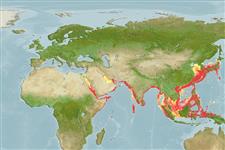Environment: milieu / climate zone / Mức độ sâu / distribution range
Sinh thái học
Biển; Nước ngọt; Thuộc về nước lợ gần đáy; Ở đại duơng, biển; Mức độ sâu ? - 800 m (Ref. 100719), usually ? - 300 m (Ref. 9942). Subtropical; 47°N - 4°S, 30°E - 143°E (Ref. 54598)
Indo-West Pacific: Red Sea, Persian Gulf, west coast of India, and Sri Lanka to Fiji and Tuvalu (Ref. 12596), north to Japan and Korea, south to the Arafura Sea (Ref. 9819) and northern Australia. Migrated to the Mediterranean via the Suez Canal (Ref. 6724).
Bộ gần gũi / Khối lượng (Trọng lượng) / Age
Chín muồi sinh dục: Lm ? range ? - ? cm
Max length : 220 cm TL con đực/không giới tính; (Ref. 559); common length : 80.0 cm TL con đực/không giới tính; (Ref. 3397); Tuổi cực đại được báo cáo: 15 các năm (Ref. 72462)
Các tia vây lưng cứng (tổng cộng) : 0; Tia cứng vây hậu môn: 0; Động vật có xương sống: 145 - 159. Snout long; eye diameter 2-2.5 times in snout length; posterior nostrils much closer to eyes than to anterior nostrils; mouth very large; teeth generally large and conspicuous (Ref. 4832). Head broader, interorbital about 8 times in head; lateral-line pores before anus 44-47; dorsal-fin rays before anus 66-78; vertebrae 145-159 (Ref. 9830).
Body shape (shape guide): eel-like.
Occurs from the littoral zone to the upper bathy-benthic region (Ref. 9942, 11230). Inhabits soft bottoms (Ref. 11230), also found in estuaries. Sometimes enters freshwater environment (Ref. 9987). Feeds on small bottom fishes and crustaceans. Captured and cultured for fishery in Japan. Marketed mainly fresh (Ref. 7238). Also used as bait for shark fishing (Ref. 2872). Also caught by bag (dol) nets. Used in Chinese medicine (Ref. 12166).
Masuda, H., K. Amaoka, C. Araga, T. Uyeno and T. Yoshino, 1984. The fishes of the Japanese Archipelago. Vol. 1. Tokai University Press, Tokyo, Japan. 437 p. (text). (Ref. 559)
IUCN Red List Status (Ref. 130435: Version 2025-1)
Threat to humans
Harmless
Human uses
Các nghề cá: tính thương mại cao; Nuôi trồng thủy sản: Tính thương mại; cá để chơi: đúng; mồi: occasionally
Các công cụ
Special reports
Download XML
Các nguồn internet
Estimates based on models
Preferred temperature (Tài liệu tham khảo
123201): 11.6 - 23.2, mean 17.4 °C (based on 401 cells).
Phylogenetic diversity index (Tài liệu tham khảo
82804): PD
50 = 0.6250 [Uniqueness, from 0.5 = low to 2.0 = high].
Bayesian length-weight: a=0.00427 (0.00162 - 0.01121), b=3.06 (2.84 - 3.28), in cm total length, based on LWR estimates for this (Sub)family-body shape (Ref.
93245).
Mức dinh dưỡng (Tài liệu tham khảo
69278): 4.4 ±0.67 se; based on food items.
Generation time: 5.8 ( na - na) years. Estimated as median ln(3)/K based on 1
growth studies.
Thích nghi nhanh (Tài liệu tham khảo
120179): Trung bình, thời gian nhân đôi của chủng quần tối thiểu là 1.4 - 4.4 năm (Tmax=15; K=0.19-0.33; Min Rel Fec=153).
Prior r = 0.57, 95% CL = 0.37 - 0.85, Based on 3 data-limited stock assessments.
Fishing Vulnerability (Ref.
59153): High vulnerability (62 of 100).
🛈
Climate Vulnerability (Ref.
125649): Very high vulnerability (85 of 100).
🛈
Nutrients (Ref.
124155): Calcium = 30.7 [16.9, 59.0] mg/100g; Iron = 0.831 [0.484, 1.436] mg/100g; Protein = 19.1 [16.9, 21.6] %; Omega3 = 0.339 [0.157, 0.993] g/100g; Selenium = 66.3 [35.3, 123.9] μg/100g; VitaminA = 6.96 [2.12, 22.85] μg/100g; Zinc = 0.412 [0.295, 0.612] mg/100g (wet weight);
